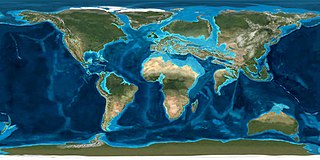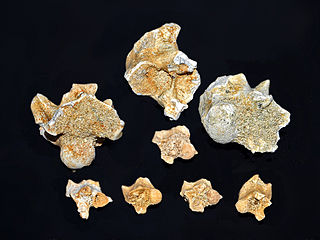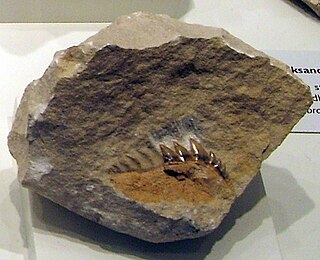
Scyliorhinus is a genus of catsharks in the family Scyliorhinidae. This genus is known in the fossil records from the Cretaceous period, late Albian age to the Pliocene epoch.
The Thanetian is, in the ICS Geologic timescale, the latest age or uppermost stratigraphic stage of the Paleocene Epoch or Series. It spans the time between 59.2 and56 Ma. The Thanetian is preceded by the Selandian Age and followed by the Ypresian Age. The Thanetian is sometimes referred to as the Late Paleocene.

In the geologic timescale the Ypresian is the oldest age or lowest stratigraphic stage of the Eocene. It spans the time between 56 and47.8 Ma, is preceded by the Thanetian Age and is followed by the Eocene Lutetian Age. The Ypresian is consistent with the lower Eocene.
The Lutetian is, in the geologic timescale, a stage or age in the Eocene. It spans the time between 47.8 and41.2 Ma. The Lutetian is preceded by the Ypresian and is followed by the Bartonian. Together with the Bartonian it is sometimes referred to as the Middle Eocene Subepoch.

Palaeophis is an extinct genus of marine snake that is the type genus of the extinct snake family Palaeophiidae.

Phosphatherium escuillei is a basal proboscidean that lived from the Late Paleocene to the early stages of the Ypresian age until the early Thanetian some 56 million years ago in North Africa. Research has suggested that Phosphatherium existed during the Eocene period.
Igdabatis is a prehistoric genus of ray whose fossils are found in rocks dating from the Maastrichtian stage of Spain, the Dukamaje Formation of Niger and the Takli, Lameta, Fatehgarh and Intertrappean Beds Formations of India.

Iberosuchus is a genus of extinct sebecosuchian mesoeucrocodylian found in Western Europe from the Eocene. Remains from Portugal was described in 1975 by Antunes as a sebecosuchian crocodilian. This genus has one species: I. macrodon. Iberosuchus was a carnivore, unlike the crocodilians today, they are not aquatic and are instead terrestrial.
Stratodus is a genus of giant prehistoric aulopiform fish found in Cretaceous-aged marine strata of Kansas, Alabama, Morocco, Israel, and Niger, South Dakota, Jordan. It has also been found in the Tamaguélelt Formation of Mali, dating to the Lower Eocene, indicating that Stratodus survived the Cretaceous-Paleogene extinction event. This sleek fish has an upper jaw filled with multiple rows of tiny teeth and was the largest aulopiform, reaching 5 meters in length.

Ampullinidae are a mostly extinct taxonomic family of sea snails, marine gastropod molluscs in the clade Caenogastropoda.

Cretalamna is a genus of extinct otodontid shark that lived from the latest Early Cretaceous to Eocene epoch. It is considered by many to be the ancestor of the largest sharks to have ever lived, such as Otodus angustidens, Otodus chubutensis, and Otodus megalodon.

The geology of the Isle of Wight is dominated by sedimentary rocks of Cretaceous and Paleogene age. This sequence was affected by the late stages of the Alpine Orogeny, forming the Isle of Wight monocline, the cause of the steeply-dipping outcrops of the Chalk Group and overlying Paleogene strata seen at The Needles, Alum Bay and Whitecliff Bay.
The Conglomérat de Cernay is a geologic formation in Champagne-Ardenne, northern France. It preserves fossils dating back to the Thanetian stage of the Paleocene period. The lizard Cernaycerta and placental mammal Bustylus cernaysi are named after the formation.

Onchosaurus is an extinct genus of sclerorhynchid sawskate from the Late Cretaceous. Its fossils have been found in the Cretaceous sediments of Egypt, Brazil, Congo, Morocco, France, Niger, Japan, Chile, Peru and the United States.
Saloumia is an extinct genus of the order Proboscidea. It is one of the oldest members of the order and lived in the middle Eocene of Senegal. It is known only from a single molar, whose pronounced bumpy chewing surface indicates it is probably closely related to Moeritherium.

Xiphodolamia is a rare extinct genus of mackerel shark which lived during the Eocene epoch. It is only known from isolated teeth, but has been found in Europe, Africa, and Asia. It is assumed to be pelagic, occurring more frequently in deeper water deposits, most notably the London Clay and Eocene deposits in Denmark. It is distinguished by its rectangular root and twisted blade, unique among Mackerel sharks. It is unclear what niche this specialized dentition helped exploit.

Notidanodon is an extinct genus of cow shark. Fossils ascribed to this genus are known from the Jurassic, Cretaceous, and Paleogene periods. The genus is known from every continent including Antarctica.
Aturobatis is an extinct genus of Myliobatiform ray from the Eocene epoch. It contains a single described species, A. aquensis; however, the range of variation in this species is not well understood and it is unclear whether all specimens attributed to the genus are the same species. It is also unknown to which family this genus belongs. The type locality is the Lutetian of southern France. This genus is also known from the Ypresian of the United States, the Lutetian Lisbon Formation of Alabama, and the Priabonian Samlat Formation of Dakhla, Morocco.
Angoumeius is an extinct genus of squaliform shark from the Eocene epoch of the Paleogene period. It is named for its type locality, Angoumé, France. It is known from a single species, A. paradoxus. It is known from many isolated teeth from the Lutetian stage. The inferred dentition is highly unusual for so its familial placement and relationship with other genera remains uncertain. It may be close to Kitefin or Sleeper sharks.
Dagbatitherium is an extinct genus of proboscideans. So far a single molar from the phosphate basins of Togo in West Africa has been found. The fossil dates to the Middle Eocene, around 47 million years ago. A striking feature of the tooth are the three pairs of cusps oriented transversely to the longitudinal axis of the tooth. This feature is found in more derived proboscideans, which are grouped in the Elephantiformes. For its age, Dagbatitherium is the earliest member of Elephantiformes to date. Furthermore, it is characterized by a low tooth crown and a humped occlusal pattern. The genus was described in 2021.










